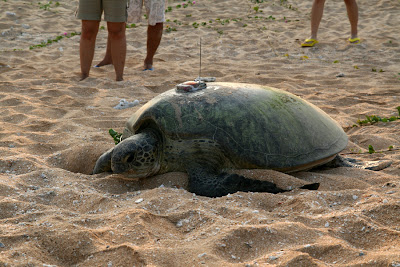
A green turtle swims in a tank at the Turtle Conservation Centre, on Wang-an island, in Penghu.
Female turtles used to nest on many beaches around the island; but industrialisation, the loss of beach areas to development; as well as the killing of turtles for their meat and shells; and poaching of their eggs caused a rapid decimation of turtle populations.
There are now just two main nesting areas: in the Penghu archipelago (where several beaches are now protected reserves) and on Orchid Island. Both have documented around 12 female nesting turtles .a tiny population if you compare the same number, say in Hawaii..where populations are as high as 600.
The turtles are now a protected species in Taiwan. And efforts are underway to conserve the remaining numbers.
Their shells are brown or black in colour; but their bodies have a greenish hue becuase their main food sources are seaweed and microalgae.
Some turtles end up by accident trapped in fishing nets. Injured turtles are treated at a vetinary clinic at the Conservation Centre in Wang-an.
 Prof. Cheng I-Jiunn, who has spent 16 years researching the green sea turtles, shows us one that's being treated at the Turtle Conservation Centre. It was found floating by the coastguard - and treated for malnutrition and minor injuries.
Prof. Cheng I-Jiunn, who has spent 16 years researching the green sea turtles, shows us one that's being treated at the Turtle Conservation Centre. It was found floating by the coastguard - and treated for malnutrition and minor injuries.
We were lucky enough to see one turtle nest on a beach. The green sea turtle is timid and only comes onto beaches to give birth at night. We were called out to one spot, where a turtle - bigger than 1 metre in length - had just laid her eggs. She was now digging a pit to carefully cover them - ferociously kicking up sand with her hind legs to cover them. It was pretty amazing to see the reptile frantically burying her eggs. And to reflect that turtles have been around 150 million years or so.
When she was finished, conservationists kept her in a wooden box on the beach overnight. They found she'd laid 138 eggs - a big batch (the average is 100-110) - which were taken back to the conservation centre, where they'll be looked after before they hatch.
Only about 70% of the eggs successfully hatch. And only 1/1000 babies actually make it to adulthood (20-50 years old) - when they will be mature enough themselves to give mate and give birth.
In one season, a turtle can nest 3-4 times; but that's it for another 3-5 years.....so its understandable why the populations are so precarious.
Early in the morning, Professor Chneg I-Jiunn, from the Institute of Marine Biology at the National Taiwan Ocean University, and student volunteers, attach a gps satellite transmitter on the turtle's back. It is state of the art equipment (costing around $7,000 US) and researchers hope it will give them vital clues about the turtle's lifecycle - especially its diving habits.
 Fixing a gps satellite transmitter
Fixing a gps satellite transmitter
After the transmitter is carefully glued, the turtle is released from its box...and inch by inch, clumsily works her way down the beach to the sea's edge.
 Ready to head home
Ready to head home  Crawling down the beach ...
Crawling down the beach ...  slowly does it...
slowly does it... Heading home, finally....
Heading home, finally....

Turtles usually nest on remote beaches..and try to return to the same beach for future nestings, no matter how long it takes to travel there. But it abandons the sites if they're disturbed or have disappeared.
Whether we will see this one return, still remains to be seen....

1 comment:
I want to be kept posted of if and when it returns ! Nice pictures too !
Post a Comment